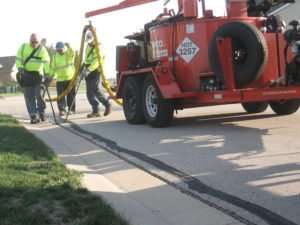
Asphalt Crack Sealing Fundamentals
 When cracks appear in your asphalt pavement, it is a good idea to have them repaired as quickly as possible. Most cracks will continue to expand, growing wider and longer in a relatively brief time; furthermore, one crack can spawn an entire series of cracks. Cracks mar the beauty of your asphalt pavement, but they also endanger its longevity. If water seeps through the cracks, the pavement’s base can be eroded and become unable to support the weight of traffic. Repairing a base can be time-consuming and costly; the existing pavement will typically need to be removed to access the base. After the base is repaired, new pavement will need to be installed. If cracks are extensive and neglected for several years, the entire pavement may have to be rebuilt. Crack filling, however, is economical and can typically be performed without creating a serious inconvenience for you or your customers.
When cracks appear in your asphalt pavement, it is a good idea to have them repaired as quickly as possible. Most cracks will continue to expand, growing wider and longer in a relatively brief time; furthermore, one crack can spawn an entire series of cracks. Cracks mar the beauty of your asphalt pavement, but they also endanger its longevity. If water seeps through the cracks, the pavement’s base can be eroded and become unable to support the weight of traffic. Repairing a base can be time-consuming and costly; the existing pavement will typically need to be removed to access the base. After the base is repaired, new pavement will need to be installed. If cracks are extensive and neglected for several years, the entire pavement may have to be rebuilt. Crack filling, however, is economical and can typically be performed without creating a serious inconvenience for you or your customers.
Asphalt Crack Sealing Fundamentals – What Is Crack Filling?
Crack filling is the process of inserting material into a crack. First, however, the crack must be properly prepared. Contractors may use a wire brush, a router or a heat lance to remove dirt, grass or pieces of rock from within the crack. They will usually follow this with a blast of compressed air to ensure that all dust is removed and that the interior of the crack is dry. The fill material is then inserted and smoothed or shaped. Filler may extend just above the pavement, but it may also be slighter lower than the pavement or flush with it.
It is critical that the cavity being filled is clean and dry. Fill material will not form a strong bond if dirt or moisture is present. If the bond is insufficient, the filler can be dislodged or pull free from the side of the crack, leaving an opening for water to penetrate.
Asphalt Crack Sealing Fundamentals – What Is Fill Material?
Several manufacturers produce filler specifically for asphalt pavement. In fact, most manufacturers produce multiple types of filler so that your contractor can select the fill material that is most suitable for the size and type of cracks, the traffic the pavement receives and the weather conditions at the time that the work is being performed. For example, there are fillers that are designed for high-traffic pavements such as busy highways, and there are fillers that are designed for parking lots that handle only a few cars each day. There are fillers that work best for small, non-working cracks, and there are fillers that are designed for large, working cracks.
Virtually all fillers can be classified as either hot-pour or cold-pour. Hot-pour fillers require a heat source, and most contractors use oil-jacketed melters for this task. Cold-pour fillers can be applied without being heated first.
If you choose a reputable asphalt company, you can trust the contractor to select the proper fill material for your pavement. The contractor will also ensure that the cracks are properly cleaned and prepared before the filler is introduced.
You Can Trust Affordable Striping & Sealing
Affordable Striping & Sealing is an asphalt maintenance and striping company that provides an extensive range of services for asphalt pavement. In addition to asphalt crack sealing, we also offer seal coat, parking lot striping, bumper blocks, traffic sign installation and road and pavement markings as well as parking lot layout and design. We are committed to excellence, choosing only the best materials and latest techniques to deliver exceptional results at affordable rates. To request a free quote, use the online form or call our office at (702) 222-9009.
Recent FAQs Below



